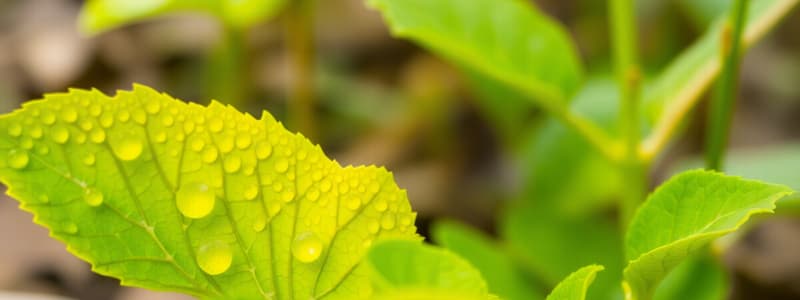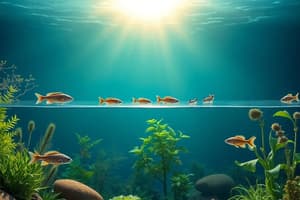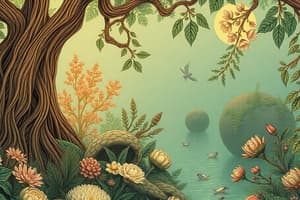Podcast
Questions and Answers
What is another term for a producer in biology?
What is another term for a producer in biology?
- Consumer
- Heterotroph
- Decomposer
- Autotroph (correct)
Producers form which part of the food web?
Producers form which part of the food web?
- The top
- The base (correct)
- The middle
- The sides
What is the main role of producers in an ecosystem?
What is the main role of producers in an ecosystem?
- To make their own food and provide energy (correct)
- To consume other organisms
- To decompose dead material
- To hunt and regulate populations
Organisms that eat producers are known as what?
Organisms that eat producers are known as what?
What are the two main types of producers based on their energy source?
What are the two main types of producers based on their energy source?
Which energy source do photoautotrophs utilize to produce food?
Which energy source do photoautotrophs utilize to produce food?
Chemoautotrophs obtain energy from which source?
Chemoautotrophs obtain energy from which source?
Which of these is a common example of a terrestrial producer?
Which of these is a common example of a terrestrial producer?
Which of the following is an example of an aquatic producer?
Which of the following is an example of an aquatic producer?
What process in aquatic ecosystems can be caused by an overgrowth of producers due to excess nutrients?
What process in aquatic ecosystems can be caused by an overgrowth of producers due to excess nutrients?
Flashcards
Producers (Autotrophs)
Producers (Autotrophs)
Organisms that can create their own food through biochemical processes, forming the base of the food web.
Food Web
Food Web
A diagram showing the transfer of energy through different species in an ecosystem, with producers forming the base.
Trophic Levels
Trophic Levels
The different levels in a food web, including producers, consumers (primary, secondary, tertiary), and decomposers.
Consumers
Consumers
Signup and view all the flashcards
Photoautotrophs
Photoautotrophs
Signup and view all the flashcards
Chemoautotrophs
Chemoautotrophs
Signup and view all the flashcards
Terrestrial Producers
Terrestrial Producers
Signup and view all the flashcards
Aquatic Producers
Aquatic Producers
Signup and view all the flashcards
Eutrophication
Eutrophication
Signup and view all the flashcards
Chemosynthetic Bacteria
Chemosynthetic Bacteria
Signup and view all the flashcards
Study Notes
- Producers, also known as autotrophs, create their own food through biochemical processes.
- They form the base of the food web, providing energy for all other organisms.
- Producers are one trophic level within a food web that demonstrates energy transfer between species.
Trophic Levels
- Trophic levels are the layers within a food web containing:
- Producers
- Primary consumers
- Secondary consumers
- Tertiary consumers
- Decomposers
- Consumers eat other organisms for energy, unlike producers.
- Primary consumers eat only producers, usually plants, making them herbivores.
- Secondary consumers eat primary consumers and producers; they can be carnivores or omnivores.
- Tertiary consumers, usually carnivores, eat primary and secondary consumers, and sometimes producers.
- Decomposers recycle nutrients by breaking down dead material.
Types of Producers
- Photoautotrophs use sunlight to create glucose through photosynthesis.
- Chlorophyll captures sunlight energy to create ATP and NADPH, which fix carbon dioxide into glucose.
- Chemoautotrophs use energy from inorganic chemicals to create glucose through chemosynthesis.
- They use molecules like hydrogen sulfide to fix carbon dioxide into glucose.
Photoautotrophs vs. Chemoautotrophs
- Energy Source:
- Photoautotrophs: Sunlight
- Chemoautotrophs: Inorganic molecules
- Products:
- Photoautotrophs: Glucose and oxygen
- Chemoautotrophs: Glucose, sulfur, and water
- Examples:
- Photoautotrophs: Green plants
- Chemoautotrophs: Deep sea bacteria
Examples of Producers
- Terrestrial producers, like plants, live on land.
- Roots anchor the plant.
- Stems position the plant to gather sunlight.
- Leaves containing chlorophyll conduct photosynthesis.
- Examples include grasses, trees, and shrubs.
- Aquatic producers include algae in water ecosystems.
- Multicellular algae, like kelp, use holdfasts to attach to underwater substrates.
- Leaves contain chlorophyll for photosynthesis.
- Diatoms are single-celled, microscopic algae that act as photosynthetic producers and are used in silver polish and toothpaste manufacturing.
- Seagrass are true aquatic plants that are photosynthetic producers.
- Chemoautotrophs are key producers in deep-sea hydrothermal vents where chemosynthetic bacteria use inorganic molecules to create food that supports complex ecosystems.
Importance
- Producers are the foundation of energy transfer in ecosystems; too few can disrupt the food web.
- Overgrowth of producers, eutrophication, can occur when excess nutrients like phosphorus and nitrogen are added to aquatic ecosystems due to pollution.
- Eutrophication leads to cyanobacteria overgrowth, disrupting the ecosystem and causing dead zones.
Studying That Suits You
Use AI to generate personalized quizzes and flashcards to suit your learning preferences.




